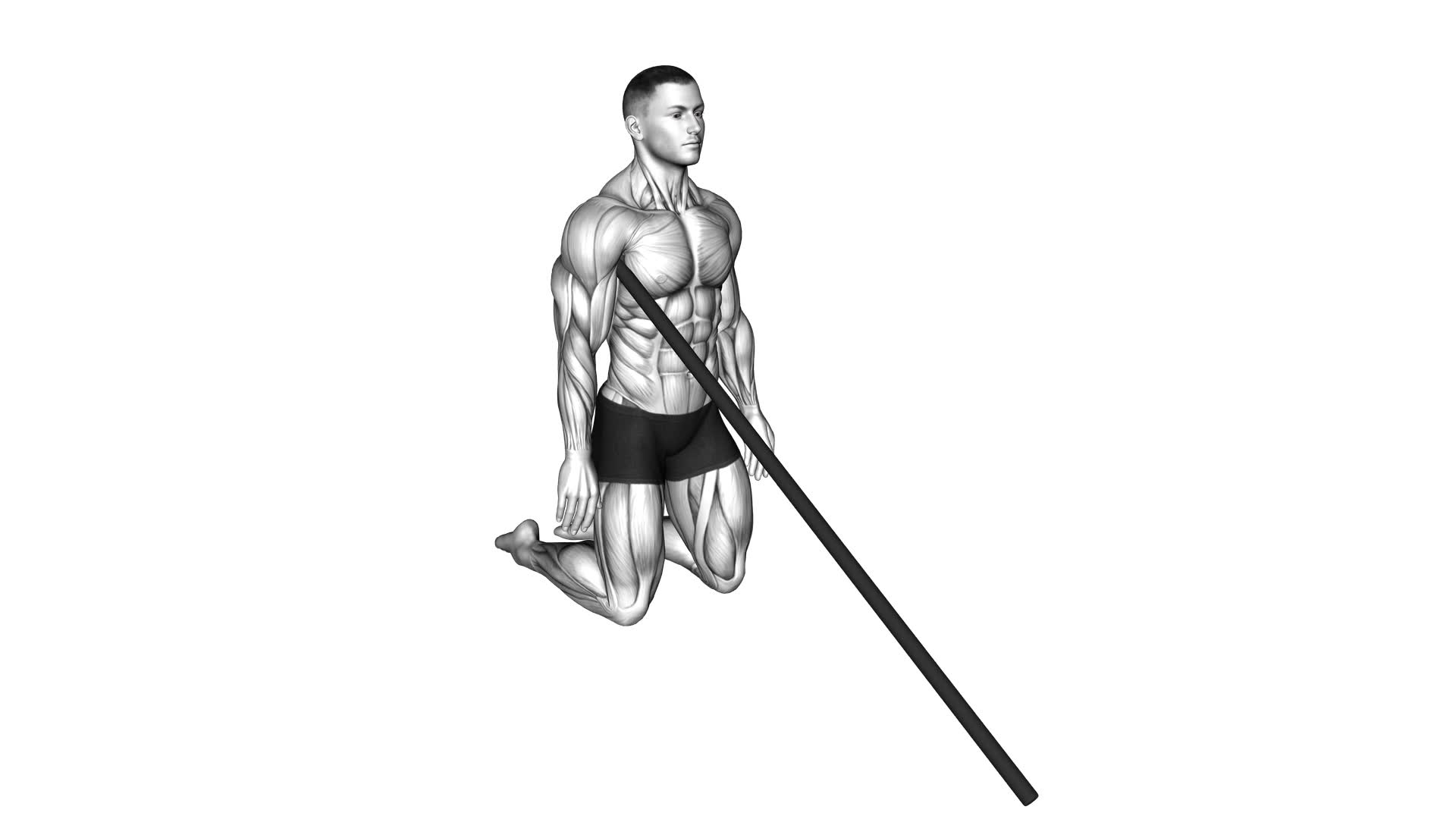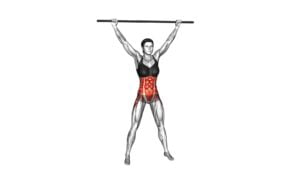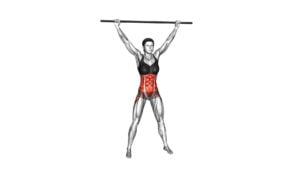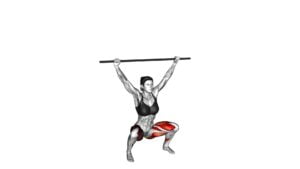Stick Subscapularis Muscle Relax (male) – Video Exercise Guide & Tips

Looking to relax your subscapularis muscle? Check out this video exercise guide and tips for stick subscapularis muscle relaxation.
Watch This Exercise Video
In this guide, you'll find the benefits of this exercise, the equipment you'll need, proper form and technique, as well as tips to enhance its effectiveness.
Whether you're a beginner or advanced fitness enthusiast, we've got you covered with precautions and modifications for different fitness levels.
So grab your stick and get ready to unwind those tight muscles!
Key Takeaways
- Stick subscapularis muscle relaxation improves shoulder mobility and reduces pain and discomfort.
- Using a stick or foam roller can increase flexibility of the muscle and surrounding tissues.
- Proper form and technique include maintaining a neutral spine, engaging core muscles, and moving slowly and deliberately.
- To enhance the effectiveness of the exercise, engage core muscles for stability, start with light pressure and gradually increase, incorporate variations, and avoid excessive force or pressure.
Benefits of Stick Subscapularis Muscle Relaxation
Improve your shoulder mobility and reduce pain with stick subscapularis muscle relaxation.
The subscapularis muscle, located in the front of the shoulder, plays a crucial role in shoulder stability and movement. When this muscle becomes tight or restricted, it can lead to limited range of motion and discomfort. Stick subscapularis muscle release is a technique that targets this specific muscle to promote relaxation and alleviate tension.
To perform stick subscapularis muscle relaxation, you'll need a stick or a foam roller. Start by lying on your back with the stick positioned horizontally across your chest, just below the collarbone. Hold the stick with both hands, keeping your elbows bent. Slowly roll the stick up and down the length of your chest, applying gentle pressure to the subscapularis muscle. Focus on any areas of tightness or discomfort, and spend extra time on those areas to release tension.
This technique works by applying pressure to the subscapularis muscle, which helps to stretch and relax the muscle fibers. It can improve shoulder mobility by increasing the flexibility of the muscle and surrounding tissues. Stick subscapularis muscle relaxation can also reduce pain and discomfort associated with tightness in the shoulder.
Incorporating stick subscapularis muscle relaxation into your regular exercise routine can be beneficial for individuals who experience shoulder stiffness, limited range of motion, or discomfort. It's a simple and effective technique that can be done at home or in a gym setting. Remember to listen to your body and adjust the pressure and intensity of the technique as needed.
Equipment Needed for the Exercise
To perform stick subscapularis muscle relaxation, you'll need a stick or a foam roller. These tools are essential for targeting and effectively stretching the subscapularis muscle. When choosing a stick, make sure it's long enough to reach the desired areas of your shoulder and arm. A foam roller should be firm and durable to provide adequate pressure and support.
Exercise variations for subscapularis muscle relaxation include using a shorter stick or foam roller to target specific areas of the muscle. You can also vary the intensity by applying more or less pressure during the exercise. Experiment with different positions, such as lying on your back or standing against a wall, to find what works best for you.
It is important to be aware of common mistakes to avoid during stick subscapularis muscle relaxation. One common mistake is using excessive force or pressure, which can lead to injury. Remember to start with light pressure and gradually increase as your muscles become more flexible. Another mistake is neglecting proper form and technique. Maintain a neutral spine and engage your core muscles throughout the exercise to prevent strain on your back.
Now that you know the equipment needed for stick subscapularis muscle relaxation, let's move on to the next section about proper form and technique for the exercise.
Proper Form and Technique for the Exercise
To perform stick subscapularis muscle relaxation with proper form and technique, it's important to focus on maintaining a neutral spine, engaging your core muscles, and using controlled movements throughout the exercise. This will ensure that you target the subscapularis muscle effectively and minimize the risk of injury.
One common mistake people make when performing this exercise is allowing their back to round or arch excessively. This puts unnecessary strain on the spine and takes the emphasis away from the subscapularis muscle. To avoid this, imagine a string pulling your head towards the ceiling, keeping your spine straight and aligned.
Another mistake is using momentum to swing the stick instead of relying on your muscles to control the movement. This reduces the effectiveness of the exercise and can lead to muscle imbalances. Remember to move slowly and deliberately, focusing on engaging the subscapularis muscle throughout the entire range of motion.
If you find the stick subscapularis muscle relaxation too challenging or if you want to add variety to your routine, there are alternative exercises you can try. One option is the standing dumbbell internal rotation exercise. This involves holding a dumbbell in one hand, keeping your elbow at a 90-degree angle, and rotating your forearm inward. This exercise targets the subscapularis muscle and can be easily modified to suit your fitness level.
Tips to Enhance the Effectiveness of the Exercise
Engage your core muscles throughout the exercise to optimize the effectiveness of stick subscapularis muscle relaxation. By doing so, you'll ensure that your body remains stable and supported, allowing for proper alignment and activation of the targeted muscles. This will enhance the overall effectiveness of the exercise and help you achieve the desired results.
To further enhance the effectiveness of the stick subscapularis muscle relaxation, it's important to avoid common mistakes. One common mistake is using excessive force or pressure on the stick, which can lead to strain or injury. Remember to start with light pressure and gradually increase it as your muscles become more accustomed to the exercise.
Another mistake to avoid is neglecting variations of the exercise. By incorporating different variations, you can target the subscapularis muscle from various angles, promoting overall muscle balance and strength. Some variations include changing the grip width on the stick or adjusting the position of your arms during the exercise.
By engaging your core muscles, avoiding common mistakes, and incorporating variations, you can maximize the effectiveness of the stick subscapularis muscle relaxation exercise. This will help you achieve optimal results and improve your overall shoulder strength and flexibility.
Transition Sentence: Now that you have learned how to enhance the effectiveness of the exercise, let's move on to discussing precautions and modifications for different fitness levels.
Precautions and Modifications for Different Fitness Levels
Now that we've discussed how to enhance the effectiveness of the stick subscapularis muscle relaxation exercise, let's move on to discussing precautions and modifications for different fitness levels.
When performing the stick subscapularis muscle relaxation exercise, it's important to take certain precautions, especially if you have a history of shoulder injuries. If you have any existing shoulder conditions or discomfort, it's advisable to consult with a healthcare professional before attempting this exercise. Additionally, if you experience any pain or discomfort during the exercise, you should stop immediately and seek medical advice.
For individuals who are new to fitness or have limited upper body strength, modifications can be made to gradually build up to the full exercise. Instead of using a stick, you can start by using a foam roller or a towel to perform the exercise. This will provide a gentler stretch and allow you to gradually increase the intensity as you become more comfortable.
On the other hand, for advanced athletes looking to progress the exercise, there are a few progressions that can be incorporated. One option is to increase the weight of the stick by attaching small weights to each end. This will require more strength and stability in the shoulder muscles. Additionally, you can perform the exercise in a standing position rather than sitting, which will engage more core muscles and further challenge your stability.
Frequently Asked Questions
How Long Should I Hold the Stick Subscapularis Muscle Relax Exercise For?
To maximize shoulder mobility and reap the benefits of stretching, it's important to know how long to hold the Stick Subscapularis Muscle Relax exercise.
The ideal duration for this exercise is typically around 30 seconds to 1 minute. Holding the stretch for this length of time allows the subscapularis muscle to relax and lengthen, promoting increased range of motion and flexibility in the shoulder joint.
Can Stick Subscapularis Muscle Relax Help With Shoulder Pain Caused by an Injury?
Stick subscapularis muscle relax can be effective for chronic shoulder pain caused by injury. By incorporating this exercise into your shoulder rehabilitation program, you can benefit from its ability to target and release tension in the subscapularis muscle. This muscle is commonly involved in shoulder pain and tightness.
Stick subscapularis muscle relax can help improve range of motion, reduce pain, and restore proper function to the shoulder joint. It's important to consult with a healthcare professional for a personalized rehabilitation program.
Is Stick Subscapularis Muscle Relax Suitable for Beginners?
Stick subscapularis muscle relax is suitable for beginners. It provides numerous benefits for those new to exercise. This exercise helps to relax and stretch the subscapularis muscle, which is important for maintaining shoulder flexibility and preventing injuries.
There are various variations of this exercise that can be performed depending on your comfort level and fitness goals. Stick subscapularis muscle relax is a great addition to any beginner's workout routine.
Should I Consult a Healthcare Professional Before Attempting Stick Subscapularis Muscle Relax?
Before attempting stick subscapularis muscle relax, it's advisable to consult a healthcare professional. This exercise can provide several benefits, including relaxation of the subscapularis muscle and increased range of motion in the shoulder.
However, it's important to take precautions to avoid injury. A healthcare professional can assess your individual needs, ensure that you're performing the exercise correctly, and provide guidance on any modifications or alternatives that may be necessary for your specific situation.
Are There Any Alternative Exercises That Target the Subscapularis Muscle?
There are indeed alternative exercises that specifically target the subscapularis muscle. By engaging in exercises like the lying internal rotation or the dumbbell external rotation, you can effectively strengthen and stretch the subscapularis muscle.
These exercises offer similar benefits as the stick subscapularis muscle relax, such as improved shoulder mobility and stability. Incorporating these alternative exercises into your routine can provide a well-rounded approach to targeting the subscapularis muscle and promoting overall shoulder health.
Conclusion
In conclusion, stick subscapularis muscle relaxation is a beneficial exercise for improving shoulder mobility and flexibility. By using a stick or broom handle, individuals can effectively stretch and release tension in the subscapularis muscle.
It's important to maintain proper form and technique during the exercise to maximize its effectiveness. Additionally, incorporating tips such as breathing deeply and gradually increasing the stretch can enhance the benefits of this exercise.
It's recommended to consult with a fitness professional for modifications based on different fitness levels.

Author
Years ago, the spark of my life’s passion ignited in my mind the moment I stepped into the local gym for the first time. The inaugural bead of perspiration, the initial endeavor, the very first surge of endorphins, and a sense of pride that washed over me post-workout marked the beginning of my deep-seated interest in strength sports, fitness, and sports nutrition. This very curiosity blossomed rapidly into a profound fascination, propelling me to earn a Master’s degree in Physical Education from the Academy of Physical Education in Krakow, followed by a Sports Manager diploma from the Jagiellonian University. My journey of growth led me to gain more specialized qualifications, such as being a certified personal trainer with a focus on sports dietetics, a lifeguard, and an instructor for wellness and corrective gymnastics. Theoretical knowledge paired seamlessly with practical experience, reinforcing my belief that the transformation of individuals under my guidance was also a reflection of my personal growth. This belief holds true even today. Each day, I strive to push the boundaries and explore new realms. These realms gently elevate me to greater heights. The unique combination of passion for my field and the continuous quest for growth fuels my drive to break new ground.







